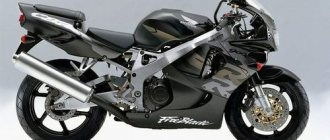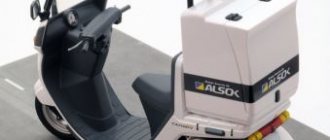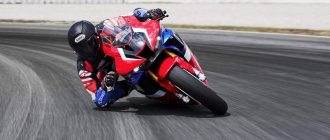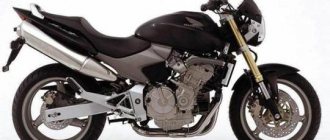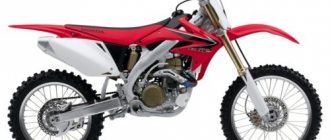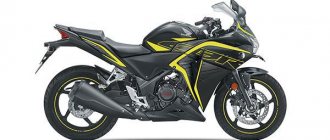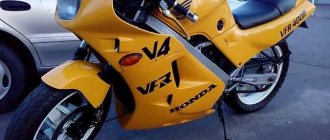Continuing the development of the “fiery blade” CBR900, Honda engineers realized that further updates would move the motorcycle into a higher class – liter models. Therefore, in 2004, work on the old model was completed.
Its place on the assembly line is given to the Honda CBR1000 - the new “blade of fire”.
The motorcycle received all the developments of its prototype, as well as many innovations. It was natural to include all already proven solutions.
In addition, the newcomer received an updated frame, suspension and something that the owners of the first blade were missing - a steering damper based on electronic brains. The concern's own development is Honda Electronic Steering Damper (HESD) .
The release continues. Since the model was launched into production, there have been 4 (according to some sources 5) restylings.
Specifications
One of the reasons that the developers did not change the engine during restyling is that the factory simply did not have a good engine that would competently communicate with all the electronics crammed into the bike.
And if other technical components could be taken from the prototype, then the difference in classes cannot be easily jumped over. The engine was drawn from scratch , but it turned out to be so successful that it created the basis for the development of two more bikes, which Honda took up after the second “blade” went into production.
- Honda CB1000R;
- Honda CBF 1000.
They have identical engines with an artificially reduced number of horses, which is interesting considering that both have LITERS!
Engine covers are the first to suffer when dropped; arches or protective sliders will help preserve them.
This 4-cylinder, 4-stroke engine with in-line pistons can produce:
- working volume - 998 cm3;
- power - 174 hp (from 2021 - 192);
- number of valves - 16 (4 per cylinder);
- cooling - liquid;
- fuel supply - injector;
- ignition - digital;
- start - electric starter;
- fuel tank - 16 l.
The latest builds have received Honda's own Selectable Torque Control traction control system. Other brands call it more simply - traction control .
Transmission and clutch
The rear swingarm is highly rigid, despite its impressive length.
The 6-speed gearbox installed on the motorcycle is constantly being improved during the production process.
- 2008 - the first overhaul, the clutch slip function appeared;
- 2011 - second bulkhead, change in gear ratios.
The operating principle is sequential, the clutch is multi-plate in an oil bath. Drive - chain
Depending on the year of manufacture, the clutch can be hydraulic (models 2005-2007) or standard, via a cable.
Brakes
The diameter of the front discs changed during the release of test models, but unlike the prototype, they were limited to a size of 320 mm. According to the developers, such a system should become softer, brake more smoothly, and generally increase comfort.
The front wheel has radial brake calipers, as befits a “supersport”.
Front brakes:
- number of disks - 2;
- diameter - 310, 320 mm;
- support - 4-piston.
Rear brakes:
- number of disks - 1;
- diameter - 220 mm;
- support - 1-piston.
In 2009, combi-breaks + ABS . Owners of earlier models could install them as options. New customers received immediately.
History of changes
Playing the role of a flagship, the Honda CBR1000RR has been constantly improved.
In 2004, the base model Honda CBR1000 launched, becoming the seventh generation of Fireblade.
Since 2006, the 8th generation version of the Honda CBR1000RR Repsol has become available. The exterior of the motorcycle was changed (as in the photo), the rear suspension pendulum was lightened, the fairing design and chassis geometry were redesigned, and new brake discs of larger diameter were installed at the front. The weight of the bike has decreased slightly, and the engine power has increased.
The ninth generation, released in 2008, featured a completely new engine with a volume of 999 cm³, titanium intake and exhaust valves, and an increased compression ratio. Maximum power increased again to 151 hp. With. at 10 thousand rpm. The chassis of the vehicle has changed radically, as a result of which the weight has been reduced even more and the center of gravity has decreased.
The year 2009 was marked by the launch of the ninth generation of Fireblade. It differed only in the installation of a combined anti-lock brake system and a change in the design of the turn signals.
In the eleventh generation (2010), engineers retuned the engine and gearbox to improve low-end traction and smoother power growth depending on speed. The model received easily removable license plate mounts, making it easier to prepare the device for the race.
In 2012, in the 12th generation, the designers improved the aerodynamics, equipped the motorcycle with 12-spoke wheels, an instrument panel with an LCD display, and new Showa suspensions. The ABS was also reconfigured.
Honda CBR1000RR Fireblade
Features of the 2014 Honda SBR 1000 RR model - updated windshield (pictured). The engine has been modified to produce higher power.
Driving performance
The maximum speed is 286 km/h , but there is a small power reserve.
Acceleration to hundreds
Acceleration from zero to 100 km according to test measurements is 2.94 seconds .
Fuel consumption
According to the developers, the model should consume no more than 6 liters for urban use. The final result depends on the track and the driver's driving style.
Dimensions and weight
Installing ABS normally increases the total weight by 10–12 kg.
The “liter” Fireblade stands out among its classmates due to its large dimensions and weight.
The first versions with this option weighed more than 200, but constant work on fleshing out the bike led to a reduction in curb weight from 210 kg (beginning of production) to 196 kg (2017–2018 models).
When modeling the new “blade,” the developers decided that the saddle height should not differ from the first version. Therefore, regardless of changes in other dimensional parameters, the pilot’s seat was not changed. The ground clearance also remained unchanged.
The remaining parameters changed from 2 (width) to 5 times (length):
- the length of the motorcycle increased by 30 mm - from 2035 to 2065 mm;
- width decreased - from 320 to 685 mm;
- the motorcycle has become higher by 5 mm - from 1120 to 1125 mm;
- while the height of the saddle was 820 mm (all versions);
- the wheelbase also increased by 5 mm - from 1405 to 1410 mm.
- ground clearance - 130 mm.
Who is it suitable for?
In general, the “Fire” is considered the most suitable bike for civilian use, unlike many “liter” classmates.
The raised pegs of the first blade, as conceived by the developers, were supposed to provide the opportunity to purchase a motorcycle to a larger number of users. But in the end, high footpegs did not become more comfortable for tall riders ( bending their knees more and stretching ), and short ones preferred to choose a more comfortable version.
The new blade was corrected and the saddle fixed in height, as well as lower footpegs, created a certain comfort for motorcyclists of medium and tall height.
Lower pilots are advised to look towards other models, or when choosing this one, be attentive to their feelings and take a longer test drive (if possible).
Hi all! MotoZak is always in touch!
This time the video is not at all hype, perhaps even useful for owners of this model. My friend and comrade was about to install a new motor in his fireball (as BOLT would say) and asked, is there any content? Of course, I didn't refuse. First of all, I myself was interested in gaining useful experience, seeing how everything would be put back together and, of course, helping in any way if needed. The video turned out to be quite small, but I tried to dilute it with funny moments (how we dropped the engine once) and useful inserts (how to count mistakes on a motor, etc.), so I advise you to take something for the foamy golden beauty and wish you a pleasant viewing!
Of course, there is a text version in a stripped down format ->
I will try to inform you as briefly and informatively as possible. Before I left for the army (11/20/19) in the 2021 season, my friend Dimooooon (music from Boomer) did quite a lot of maintenance for his 2008 Fire (adjusting valves, replacing the tensioner, all possible gaskets, spark plugs, sprockets and chain (mileage I won’t tell you which one). Everything was done well, nothing bothered me, the bike worked as it should. We rode the motorcycle to the Crimea, then to some other Fest, the fire did not let us down, because this is a Honda - the standard of quality and reliability. I was in that season I was without my “Chernysh”, because my dad decomposed quite well on it, there is a separate post When the soldiers had already accepted me, I had long trampled the platform, fell on take-off, completed the military training camp and “enjoyed” other sweets of the army before me I received information that Dimon's engine burped. The news did not please me, because I always treat any things as if they were my own. And yesterday Dimon wrote to me: - I will install a new engine, come if you want to take pictures, we'll see you at the same time, together more fun. I flew into the garage and began to split hairs. During the installation, she told about the cause of the breakdown, more precisely about the disease of this year of production 2008-2009. That their crankshaft main gear was crumbling (time code 02:20). I was sad to hear this, after all, I have always heard only positive things about Hondas (I am an ardent fan of this brand myself). By the way, Dimon is selling the old motor, if anyone is interested, write to me in PM, I will arrange it (don’t think, I don’t have any gain, everything is purely friendly). There is a review of the motor at the end of the video (time code 20:14), we removed the pan and showed what the problem is in general.
Dimon's new engine cost 100,000₽, I think he made it on time, because... all prices begin to fly to heaven. He said that it was possible to simply find a knee from the age of 10, but it didn’t work out for him, so he decided to go this way. The seller gave guarantees for installing the motor, taking it for a ride and looking at its overall performance, and then discussing this point further. Before installation, we did some stripping for prevention. After measuring the compression, it turned out 1=12, 2=11, 3=10 and 4=11 (time code 12:08). He said that this is the norm for a fireball, because... on the previous one he had just 11, after adjustment. The installation process turned out to be not difficult, we raised the engine to its rightful place, inserted the guides, tightened it, put on the attachments, electrics and that's it, you can try to start the engine.
And this is where the real fun began. When they did the stripping, naturally the injectors were not connected, the brains remembered these errors (we don’t know about this yet). To celebrate, we begin to try to start the engine (time code 16:00) with great effort, but the engine starts. We feel that something is wrong. Sometimes it adjusts and when you open the gas, it starts to stall. We started looking at what we missed and didn’t connect. We found a vacuum hose that they forgot to connect to the airbox and fixed it. Did not help. We began to think further about what this could be. When we installed the throttle, it has a connector into which the chip from the TP sensor is connected, but the funny thing is that there are 3 of these chips and they are the same (blue), one is for the upper injectors in the airbox, and I don’t remember the other (I use the hint - help hall). Because the motor was removed a long time ago, Dimon didn’t remember which chip was connected where, but for some reason they didn’t think to look (laziness defeated us). They trusted their intuition and logical thinking (the chip reaches out and goes in, which means everything is clear). And as luck would have it, we connected this chip we needed in the wrong place, but in exactly the place that the audience guessed. But we didn’t come to this so quickly, we didn’t think that there were 3 of them, but swapped 2, which were in front of our noses and in a convenient location, as it seemed to us. We started calling our friends, they told us that it could be the sensor of the knee of the brain, because... We moved it from the old motor (the chips were different), but in appearance, they are both absolutely the same. Nothing worked and we decided that we needed to count the errors; we spent a long time looking for information on how to do this. It turned out to be simple: under the seat there is a red diagnostic connector, we close the green and brown wires, turn on the ignition, the Check light starts blinking (To understand what the error is, the meaning is as follows -> long blinking (tens), short blinking (units), that is, 2 long and 3 short ones are 23) (time code 18:34). Link to list of errors. After receiving useful numbers, we realized where to dig next. The errors indicated that 1 injector, some sensor, etc. were not working properly. We found a bad contact in the chips, cleaned them and started resetting them. To reset the errors, the steps are as follows: the same red diagnostic connector, the ignition is turned off, we close the green and brown wires again, turn on the ignition and within 5 seconds we pull out the jumper and insert it again, the Check light should blink and light up. Thus, everything worked out for us and the errors were reset. We thought, well, that’s it, fire, now you give up and the victory is ours! But still the same song, Honda says that error 8 remains (TP sensor short circuit), we did not give up and went to look at the manual, look for what colors of wires should be on this chip (just in case, red/yellow, blue/green, gray/ black). We found the one we needed, put it in place, and the motor came to life, purring beautifully with its exhaust. Therefore, never be lazy right away, so as not to waste a lot of time. I hope everyone found it interesting, thanks to those who stuck it out and read to the end, good luck to everyone in the new season!
Modifications
Honda CBR1000RR SP Fireblade – racing version.
Lowered windshield and NIX30 Smart-EC forks.
Single seat seat.
Fully digital dashboard.
In 2014, due to popular demand, the Honda CBR1000RR SP Fireblade was born at the plant. The basic version is left to civilian motorcyclists, and the new one is positioned as a racing one.
But the driving characteristics of the stock racer are no different (!!!) from the civilian version. At the same time, it boasts out-of-the-box a quick shifter, a titanium fuel tank, Ohlins Smart EC smart electronic suspension and Brenbo brake calipers.
A distinctive feature is the presence of a small fairing instead of a perch for the second number (one saddle). In addition, the modification has a smaller amount of plastic, an open engine and starts only from the kick starter foot.
The release of the racing version continues in parallel with the main one.
Motorcycle Features
The motorcycle successfully combines excellent dynamics and comfort for the driver. The bike's handling allows it to handle equally easily both on the race track and in urban conditions.
Among the advantages of the device are: a powerful engine, modern design, excellent braking technology, an ergonomic instrument panel, accessible and inexpensive spare parts and tuning kits.
Among the shortcomings, many note the weak suspension, which often breaks on uneven roads, as well as difficult controls for a novice motorcyclist.
Honda CBR1000RR
Post Views: 3,487
Honda CBR1000RR Fireblade or Yamaha R1? Difficulty of choice
On forums dedicated to motorcycle topics, these 2 bikes are often compared. Sometimes Germans, Italians, and other Japanese are added to the pile, but most often they choose between these models.
In fact, the choice largely depends on the user’s love for the equipment of a certain brand. Don’t forget that the R1 has a civilian modification, and the fire razor has a racing version. But in essence the choice can be boiled down to one point for which Honda is famous. This is attention to the user .
The electronics of the razor will monitor the user until the last minute in order to intervene if the situation begins to get out of control. The R1 driver has more freedom of choice . It is not for nothing that sometimes in Honda advertising there is a mention of total control - complete and constant control over the situation. Only the user himself can choose what is more important to him - increased security or free recklessness.
If you look at the stuffing of the bikes, with the exception of the concerns’ own developments, it will be almost identical. Both already have traction control, acceleration to 100 is comparable (the difference is hundredths of a second), speed and fuel consumption depend on the skills of the pilot.
Disadvantages of Honda
The Honda CBR1000RR has so few disadvantages that they simply cannot prevent those who want to “ride the Fire.”
Despite all the details being worked out by Honda developers, the disadvantages are a little strange:
- Fuel consumption . A liter is a liter, but on other liter bikes of the concern during city driving the consumption is less or comparable to 600 cc ones.
- It's getting warm . When parked at a traffic light, the fan starts every minute.
- When moving around the yard (10-15 km), vibration . It disappears when accelerating.
- Weak wind protection.
- Mirrors are not critical, but I would like to have larger ones.
The last two points are solved through tuning. For razors, there are developments of large mirrors with turn signal repeaters and dimensions. And the glass can be installed from a third party.
and dignity
The undoubted advantage of the model is its spectacular appearance, harmonious and beautiful.
Owners note many advantages:
- comfortable fit;
- sensitive response to the throttle;
- powerful brakes;
- excellent, easy to read instrumentation (except for the small fly in the ointment - the lack of a fuel indicator).
